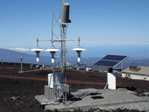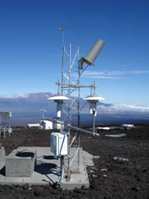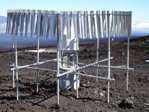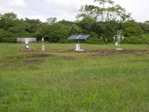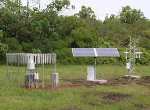More than two years after road access and electrical power to the Mauna Loa Observatory was cut off by lava flows, NOAA staff continue to make critical measurements of the atmosphere and other environmental variables at the remote site.
In 2023, observatory staff installed solar panels at the site and resumed some measurements, including the independent carbon dioxide monitoring programs run by the Global Monitoring Laboratory and Scripps Institution of Oceanography, as well as other atmospheric measurements.
Construction of a temporary road to access the observatory site is anticipated to begin in summer 2025.
Media can contact: Theo Stein (303) 819-7409 (theo.stein@noaa.gov)
Organization(s):
 National Oceanic and Atmospheric Administration (NOAA),
National Climatic Data Center
National Oceanic and Atmospheric Administration (NOAA),
National Climatic Data Center
What does this program measure?
The U.S. Climate Reference Network (USCRN) is a network of climate stations now being developed as part of a National Oceanic and Atmospheric Administration (NOAA) initiative. Its primary goal is to provide future long-term homogeneous observations of temperature and precipitation that can be coupled to long-term historical observations for the detection and attribution of present and future climate change.
The USCRN intrument suite is designed to measure the following climate related parameters:
- Air Temperature
- Precipitation
- Solar Radiation
- Wind Speed
- Surface Temperature
- Relative Humidity
How does this program work?
Every USCRN observing site is equipped with a standard set of sensors, a data logger and a satellite communications transmitter, and at least one weighing rain gauge encircled by a wind shield.
The sensors are placed on a typical 3 meter (10 ft.) instrument tower at 1.5 meters (4.5 ft.) above the surface of the ground.
The hourly observations and the fifteen minute precipitation data are stored in a data logger attached to the tower. A GOES satellite transmitter sends the data to the National Climatic Data Center where the data undergo a quality control check and are placed on the Web several times a day.
Why is this research important?
Data from the USCRN will be used in operational climate monitoring activities and for placing current climate anomalies into an historical perspective.
Are there any trends in the data?
Hourly data is made available by the USCRN at http://www.ncdc.noaa.gov/crn/hourly
How does this program fit into the big picture?
What is it's role in global climate change?
As stated above, the primary goal of this program is to provide future long-term homogeneous observations of temperature and precipitation that can be coupled to long-term historical observations for the detection and attribution of present and future climate change.
Comments and References
The photos on this page are property of NOAA Mauna Loa Observatory, but the information here has been taken from the USCRN website at http://www.ncdc.noaa.gov/crn/
Lead Investigator(s):
Bruce Baker
828-271-4018
Mark Hall (lead engineer)
865-576-0366
MLO Contact(s):
Dr. John E Barnes
808-933-6965 (x222)
Trevor Kaplan
808-933-6965 (x226)
Web Site(s)
www.ncdc.noaa.gov/oa/
climate/uscrn/
Date Started
2005

